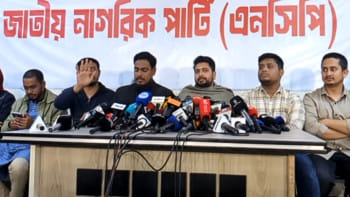Sudhin Das preserving Nazrul's treasure troves

Sudhin Das, renowned exponent of Nazrul songs for over half a century, turned 86 on April 30. Looking back, he has almost single-handedly worked painstakingly to authenticate the original notation of Nazrul Sangeet, the “swaralipi”. For his untiring commitment, he has achieved a revered status at home and abroad. He has been awarded the Ekushey Padak, Nazrul Gold Medal, Nasiruddin Gold Medal, Zebunnessa- Mahbubullah Trust Gold Medal and the Altaf Mahmood Gold Medal and amongst others. Nearly four decades after Nazrul's death, Sudhin Das is still as committed to his task as he was when he first started. Excerpts from his insightful interview...
It was a sweltering day, when I entered the Nazrul Institute. Sudhin Das was as usual, sitting deeply engrossed behind stacks of old gramophone records and busily instructing a group of young students. There was gleam in his eyes as he noticed my surprise, listening to the popular lyrics of the song, albeit a slightly different tune. “I never tire from teaching the original tunes... ” he said. As we settled down, he explained the nature of his work.

“The discs, as you know, are collected through different sources. Most often, they are in such a dilapidated condition, that, it is a painstaking job to even grasp the words, let alone decipher the delicate filigree works of the different musical forms of Nazrul songs. The songs range from classical to the folk, Ghazal to modern and one has to understand the exact technical nuances to carry on with the task,” he added.
“After Nazrul was incapacitated by neurological illness in 1942, his works fell into the hands of the so-called intellectuals and well-wishers who took advantage of the situation. From then on these were tampered beyond imagination,” says Das.
He went on to add, “I was myself a victim of circumstances. I taught the students the songs which I could easily gather from West Bengal. These works had gained immense popularity by then. But as time went on, we realised that a group with a shallow understanding of Nazrul were adapting the songs, and commercialising it for profit. This group was at the heart of distorting the poet's heritage. It was then that we started our campaign for authenticating Nazrul Sangeet notations.”
During 1976-77, a noted publication house of India, had printed a third edition of 900 songs of Nazrul. However, a careful scrutiny revealed that most of the songs in the book were not authentic. It was then that Sudhin Das visited Kolkata and challenged the works by Abdul Aziz Al Aman, the author of the notation book.
“Nazrul was very liberal with his songs and allowed eminent artistes to make variations keeping the original form intact. But, he hardly imagined that the immortal songs that he composed in Bhairabi would be tuned in Bagesree, or some of his classic songs would be sung according to whim. Singers preferred the classical genres where one could implement their own style. In contrast to Tagore songs which were structured; the singers had no option to change the style or even breathe in between words,” says Das. He adds: “ I took it as my prime responsibility to work on Nazrul's creative works which was at a risk of extinction.”
“Tagore's creations were guarded against distortion under the copyright of Biswa Bharati. However, the same was not applicable for Nazrul's literary pursuits. Nazrul's legendary popularity, his immense stock of songs and the lack of copyrights was certainly at the core of the problem.”
Three authentic notation books titled “Nazrul Swaralipi”, “Sur Mukur” (by Nazrul) and “Surlipi” (by Jagat Ghotokl) were printed before Nazrul's illness. A low spot in his life was in 1927, when he faced grave financial crisis. He was deceived by the publishers. He found it difficult to make ends meet and often sold his songs for a meagre amount.
“With such differences of opinion amongst experts, how difficult was it to start this initiative?” I asked.
“Talim Hossain, the founder GS of Nazrul Academy inspired me to work on the authentic notations of Nazrul. I took the initiative to work on this challenging job. But this project failed to continue after five publications, due to a difference of opinion,” says Das.
In 1982, the then-Executive Director of Nazrul Institute Md. Mahfuzullah took over and requested Das to work for a project in the Authentication Board of the Nazrul Institute. Stalwarts like Laila Arjumand Banu headed the board for 10 years. Other experts on the field such as Sheikh Luthfur Rahman, Sohrab Hossain, Bedaruddin Ahmed and later on Ferdousi Rahman joined in as members in the Board. Much later, eminent singer Feroza Begum took over as the President of the Board.
“In terms of preserving Nazrul's work, TV and Radio should have a cell from where Nazrul's original songs should be scrutinised. If strict measures are taken for a year the authentic tunes will once again be practised by all,” he says.
The National Poet's songs are timeless gems. One can only hope that future artistes and exponents of Nazrul Sangeet would continue to adhere to the original tune, and appreciate the true genius that was Nazrul.

 For all latest news, follow The Daily Star's Google News channel.
For all latest news, follow The Daily Star's Google News channel. 



Comments